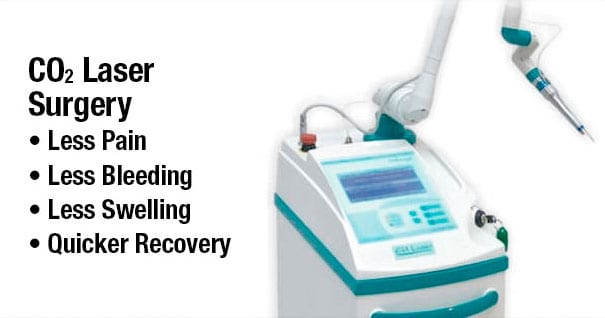CO2 Veterinary Laser Surgery
Clinical Benefits of Laser Surgery
Clients value the clinical benefits of laser surgery for veterinary care.
Laser surgery is recognized in human and veterinary medicine for its benefits to both patients and surgeons. While several types of lasers are used for different applications, a carbon dioxide laser is the primary device for soft tissue veterinary laser surgery in small and mixed animal practices.
The benefits include:
-
Reduced Pain
- The CO2 laser beam seals nerve endings as it cuts through tissue. This reduces the amount of pain the patient feels during and after surgery.
-
Reduced Bleeding
- The CO2 laser beam cauterizes and seals small blood vessels as it cuts. This laser energy achieves hemostasis (the stopping of a flow of blood) and provides the surgeon with a bloodless surgical field in most procedures.
-
Reduced Swelling
- There is no physical contact between the laser and the surgical region, eliminating the tearing and bruising of tissue associated with traditional surgical methods. Lymphatic vessels are also sealed.
-
Reduced Infection
- Laser energy acts as an antibacterial agent by producing high temperatures, effectively eliminating microorganisms.
-
Quicker Recovery
- As a result of all of the above, laser surgery provides the benefit you (and your loved pet) will appreciate the most: a quicker recovery.
Frequently Asked Questions
Why choose laser surgery for your pet?
Laser technology, with its medical use dating back to the early 1960’s, reduces trauma to your pet, shortens recovery, and often decreases the length of hospital stays for your loved ones. Veterinarians offering laser surgeries are amongst the Top 20% of animal hospitals nationwide.
What is a Laser?
Laser is an acronym for Light Amplification by the Stimulated Emission of Radiation. A laser is a device that generates an intense beam of coherent light that can cut, seal or vaporize tissue.
What types of lasers are there?
Lasers come in a variety of modalities, each suited for particular needs. CO2, diode, YAG, and other lasers are all used in human and veterinary medicine. While no laser suits all applications, CO2 lasers are by far the most common laser first purchased by a small or mixed animal practice in veterinary medicine for the reasons below.
What is a CO2 surgical laser?
The carbon dioxide (CO2) laser emits a colorless, infrared light at a specific wavelength of 10,600 microns, which has an extremely high affinity for the intercellular water of cells.
How does a CO2 surgical laser work?
The main constituent of cells, water, readily absorbs the wavelength of light produced by the CO2 surgical laser. The spectral absorption of water provides the CO2 laser with the ability to coagulate, cut, char, or ablate/vaporize tissue depending on the power density and the energy level applied by the surgeon. The surgeon can control the extent to which the laser beam is absorbed into surrounding tissue, resulting in an extremely precise tissue incision.
Why should I choose laser surgery for my pet?
A summary of the benefits the laser will provide you and your pet are:
- Less pain
- Less bleeding
- Less swelling
- Extreme precision
- Reduced risk of infection
- Quicker recovery
With the associated laser benefits, your pet will recover quicker and return home sooner.
Are lasers new?
Laser technology has been helping doctors to safely and effectively treat patients since the early 1960’s. The principles necessary for the concept of laser development date back to the early 19th century with Bohr’s theory of optical resonance. The technology is well-proven and is now being adopted by veterinarians worldwide to improve patient care.
What Type of Procedures Can a Laser Perform?
A laser is ideal for a wide variety of procedures for dogs, cats, birds, reptiles, horses, and other animals. The most widely recognized procedure amongst pet owners is the feline laser declaw. Additional procedures include but are not limited to removing cysts, tumors, and warts, as well as specialized internal procedures.



